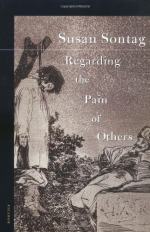
|
| Name: _________________________ | Period: ___________________ |
This quiz consists of 5 multiple choice and 5 short answer questions through Chapter 9.
Multiple Choice Questions
1. Discussing the common person's ability to feel sympathy, Sontag argues which of the following?
(a) People will instinctually distance themselves from suffering.
(b) People will do anything to keep from being moved by what they see.
(c) People will naturally feel empathy, but will quickly distance themselves because society has programmed them to avoid involvement.
(d) People will automatically feel sympathy for victims of atrocity.
2. Which of the following poets expressed concerns about the effect of national-scale events on human sensibility in 1800?
(a) Pound.
(b) Wordsworth.
(c) Hemingway.
(d) Eliot.
3. According to Sontag, anti-war sentiment:
(a) Overcame the militarized frenzy of the war years.
(b) Was considered treasonous.
(c) Produced peace.
(d) Emerged in the arts across Europe after World War I.
4. Sontag refutes the possibility of a suggestion she made in "On Photography". Which of the following ideas did she refute?
(a) An ecology of images.
(b) An abating of horrors.
(c) A ban on horrific images.
(d) A placation of the public.
5. Sontag argues that many people thought that which of the following makes war seem "real"?
(a) Proximity.
(b) Movies.
(c) Photographs.
(d) Books.
Short Answer Questions
1. Which sense did the ancient Greeks consider superior?
2. Sontag writes that provocative images may have which of the following effects on viewers?
3. Which antiwar book which shows images from German military archives does Sontag reference?
4. After World War I, the general public thought of the War as:
5. Sontag notes that post-colonial Africa is most commonly known to the American public based on a series of which of the following groups of images?
|
This section contains 385 words (approx. 2 pages at 300 words per page) |

|




